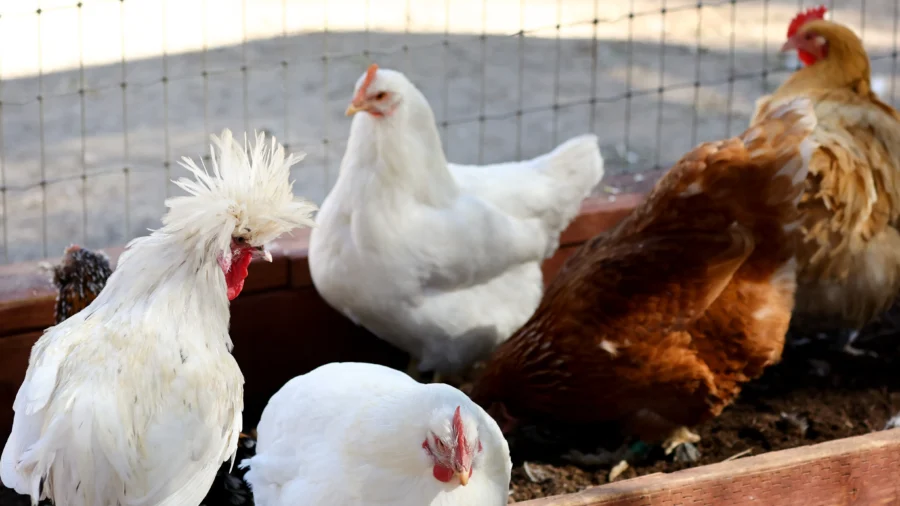A human in Michigan tested positive for highly pathogenic avian influenza, authorities announced on May 22.
The farmworker, whose name, gender, age, and other personal details were not disclosed, experienced mild symptoms and has already recovered, the Michigan Department of Health and Human Services said.
The location and name of the farm that employs the worker were also not identified.
A nasal swab from the patient tested negative but an eye swab tested positive, the U.S. Centers for Disease Control and Prevention (CDC) said.
Known symptoms of H5N1 include eye inflammation and fatigue.
The patient only reported eye symptoms, according to the agency.
The influenza, known as the bird flu and H5N1, has previously been detected in 15 dairy cattle herds and multiple poultry flocks in Michigan. Officials have been asking workers exposed to sick animals to take tests and report even mild symptoms.
“The current health risk to the general public remains low,” Dr. Natasha Bagdasarian, chief medical executive of the department, said in a statement. “This virus is being closely monitored, and we have not seen signs of sustained human-to-human transmission at this point. This is exactly how public health is meant to work, in early detection and monitoring of new and emerging illnesses.”
The CDC said that the new infection “does not change CDC’s current H5N1 bird flu human health risk assessment for the U.S. general public, which the agency considers to be low.”
“However, this development underscores the importance of recommended precautions in people with exposure to infected or potentially infected animals,” it added.
People who get close to infected cattle or other animals are advised to wear protective equipment like goggles. All people are advised to avoid eating raw or undercooked food from animals with suspected or confirmed cases.
Eye infections could result from instances such as being splashed with contaminated fluid or touching one’s eye with a contaminated hand, officials said.
High levels of H5N1 have been found in unpasteurized milk. Some samples of pasteurized milk tested positive for H5N1, but further testing showed no live virus in those samples, the U.S. Food and Drug Administration has said.
“Given the high levels of A(H5N1) virus in raw milk from infected cows, and the extent of the spread of this virus in dairy cows, similar additional human cases could be identified,” the CDC said.
Dr. Nahid Bhadelia, an infectious diseases doctor, said on the social media platform X that the second case “means that farm workers are at risk … and more may be getting sick than we know, may continue to get sick, and should be protected.”
She added: “Other humans with close contact with infected animals should be protected. And we need to reduce those infections so virus doesn’t mutate further to become a threat that transmits between humans efficiently.”
The bird flu is believed to have jumped from birds to cattle in the United States in late 2023. Since then, just one human case had been identified before the Michigan case. That farmworker in Texas has also since recovered, according to government officials.
Another person contracted the bird flu in 2022, in Colorado, and survived.
From 2003 through April 1, the World Health Organization has received reports from 23 countries of a total of 889 H5N1 cases in humans. About half of those patients died.
Additional cases with mild or no symptoms are likely to have occurred, scientists say.
As of May 21, cases in 51 herds across nine states have been confirmed by the U.S. Department of Agriculture. As of May 20, nearly 91 million poultry have been infected with the bird flu across 48 states, according to the CDC.
The U.S. Department of Agriculture on April 24 announced an order mandating testing for influenza A before moving dairy cattle across state lines. Michigan authorities on May 1 issued an emergency order that laid out a number of new measures aimed at combating spread of the bird flu, including barring the exhibition of lactating dairy cattle. President Joe Biden’s administration on May 10 announced the commitment of nearly $200 million to stem the spread of the avian influenza, including compensating dairy farmers for the loss of milk production from infected cattle.
In Australia this week, the Victoria Department of Health announced the first case of H5N1 in a child who was on a trip overseas and returned to Australia in March.
The child experienced severe symptoms but has recovered, authorities said.
The case was the first in a person or animal in Australia.
Avian influenza was also confirmed in poultry at an egg farm near Meredith, but testing showed it was caused by the H7 strain of avian influenza, not H5.
U.S. authorities say the milk, beef, and egg supply is safe, citing tests the government has performed. Australian authorities said that egg and poultry products “are safe to consume.”
From The Epoch Times


